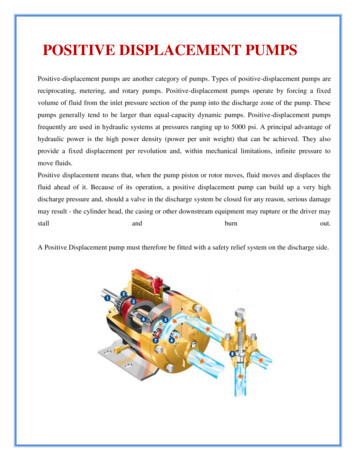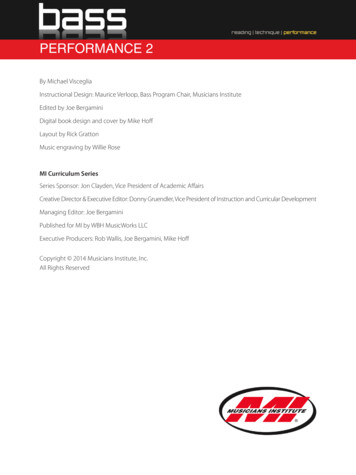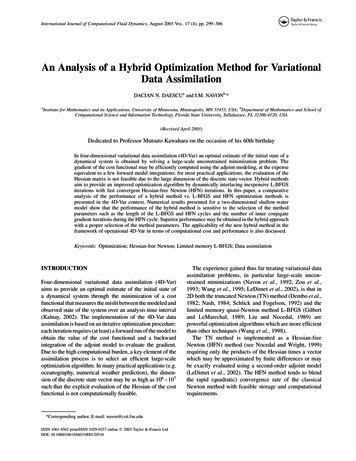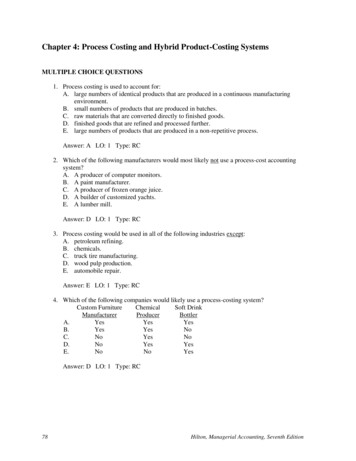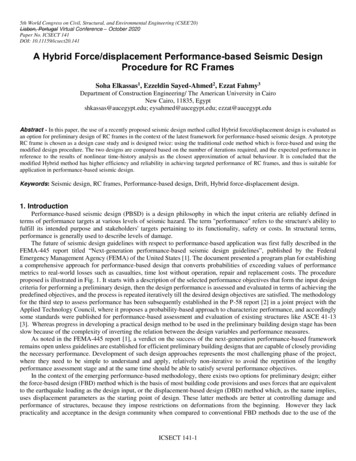
Transcription
5th World Congress on Civil, Structural, and Environmental Engineering (CSEE'20)Lisbon, Portugal Virtual Conference – October 2020Paper No. ICSECT 141DOI: 10.11159/icsect20.141A Hybrid Force/displacement Performance-based Seismic DesignProcedure for RC FramesSoha Elkassas1, Ezzeldin Sayed-Ahmed2, Ezzat Fahmy3Department of Construction Engineering/ The American University in CairoNew Cairo, 11835, Egyptshkassas@aucegypt.edu; eysahmed@aucegypt.edu; ezzat@aucegypt.eduAbstract - In this paper, the use of a recently proposed seismic design method called Hybrid force/displacement design is evaluated asan option for preliminary design of RC frames in the context of the latest framework for performance-based seismic design. A prototypeRC frame is chosen as a design case study and is designed twice: using the traditional code method which is force-based and using themodified design procedure. The two designs are compared based on the number of iterations required, and the expected performance inreference to the results of nonlinear time-history analysis as the closest approximation of actual behaviour. It is concluded that themodified Hybrid method has higher efficiency and reliability in achieving targeted performance of RC frames, and thus is suitable forapplication in performance-based seismic design.Keywords: Seismic design, RC frames, Performance-based design, Drift, Hybrid force-displacement design.1. IntroductionPerformance-based seismic design (PBSD) is a design philosophy in which the input criteria are reliably defined interms of performance targets at various levels of seismic hazard. The term "performance" refers to the structure's ability tofulfill its intended purpose and stakeholders' targets pertaining to its functionality, safety or costs. In structural terms,performance is generally used to describe levels of damage.The future of seismic design guidelines with respect to performance-based application was first fully described in theFEMA-445 report titled “Next-generation performance-based seismic design guidelines”, published by the FederalEmergency Management Agency (FEMA) of the United States [1]. The document presented a program plan for establishinga comprehensive approach for performance-based design that converts probabilities of exceeding values of performancemetrics to real-world losses such as casualties, time lost without operation, repair and replacement costs. The procedureproposed is illustrated in Fig. 1. It starts with a description of the selected performance objectives that form the input designcriteria for performing a preliminary design, then the design performance is assessed and evaluated in terms of achieving thepredefined objectives, and the process is repeated iteratively till the desired design objectives are satisfied. The methodologyfor the third step to assess performance has been subsequently established in the P-58 report [2] in a joint project with theApplied Technology Council, where it proposes a probability-based approach to characterize performance, and accordinglysome standards were published for performance-based assessment and evaluation of existing structures like ASCE 41-13[3]. Whereas progress in developing a practical design method to be used in the preliminary building design stage has beenslow because of the complexity of inverting the relation between the design variables and performance measures.As noted in the FEMA-445 report [1], a verdict on the success of the next-generation performance-based frameworkremains open unless guidelines are established for efficient preliminary building designs that are capable of closely providingthe necessary performance. Development of such design approaches represents the most challenging phase of the project,where they need to be simple to understand and apply, relatively non-iterative to avoid the repetition of the lengthyperformance assessment stage and at the same time should be able to satisfy several performance objectives.In the context of the emerging performance-based methodology, there exists two options for preliminary design; eitherthe force-based design (FBD) method which is the basis of most building code provisions and uses forces that are equivalentto the earthquake loading as the design input, or the displacement-based design (DBD) method which, as the name implies,uses displacement parameters as the starting point of design. These latter methods are better at controlling damage andperformance of structures, because they impose restrictions on deformations from the beginning. However they lackpracticality and acceptance in the design community when compared to conventional FBD methods due to the use of theICSECT 141-1
nonfamiliar displacement response spectrum [4].The two most common DBD methods are the displacement coefficientmethod and the equivalent-linearization method, which use a substitute inelastic or a highly damped elastic singledegree-of-freedom (SDOF) systems respectively, to calculate the mechanical properties using a pushover curve [5].These methods have an additional disadvantage of requiring a designed structure for adopting the SDOF representationfor analysis, and thus they cannot be used for the design of new structures and are limited to the assessment andevaluation of the seismic performance of already existing iminaryBuilding DesignNo Guidelinestill present3AssessPerformanceRevise developed inATC P-58YesDoneFig. 1: Performance-based design approach, after FEMA-445 [1].To combine the advantages of the FBD and DBD methods while still conforming to practical design formats andadditionally minimize iterations, a group of researchers have proposed a "hybrid force/displacement based design"(HFDD) for design of steel frames and have developed the method over the past 15 years specifically for performancebased engineering applications [6-10]. The core idea of this methodology is that it starts by transforming target valuesof the inter-storey drift ratio (IDR), as an indicator of non-structural damage, to a target roof displacement, and thencalculates the appropriate force reduction factor (FRF) required for limiting ductility demands to those of the estimatedtarget roof displacement ductility. The drift design criteria are repeatedly defined as associated with three basicperformance levels, and in this way, the design ensures control of both strength and drift performance for several seismicevents. In addition to the benefit of using drift and ductility demands as input variables for initiation of the designprocess, the hybrid force/displacement approach has the major advantage of avoiding the use of a substitute SDOFsystem used in DBD while retaining the use of conventional elastic response spectrum analysis and design in line withcurrent seismic codes. Recent comparisons between FBD, DBD and HFDD for the design of various types of steelstructures proves the superiority of the HFDD method over other design methods in terms of achieving pre-selectedperformance targets [11]-[14]. An initiative to utilize the same procedure for composite steel/concrete structures wasalso proven successful [15]. The HFDD method was just newly adapted to RC structures [16] where Pian and his coresearchers have developed formulations for its application to RC structures based on numerical analyses of differentheight framed structures. They employed phenomenological models (lumped plasticity) to represent the nonlinearbehaviour of reinforced concrete. Along the same frontier, the authors of this paper have extended the use of the HFDDto RC framed structures using an improved modelling technique of distributed plasticity to represent inelasticity alongmembers cross sections and lengths [17]. The used fiber-modeling technique, despite being much more computationallydemanding, is deemed more accurate in accounting for the complex hysteretic behaviour of reinforced concreteelements. The objective of this paper is to evaluate the efficiency and the reliability of this modified HFDD designmethod of RC structures. A typical example frame is analysed, and two versions of its design are compared: one usingthe traditional FBD method and the other employing the proposed HFDD method.ICSECT 141-2
2. The Modified Hybrid Design Method2. 1. ProcedureThe HFDD method is merely a variation of the FBD where the FRF are calculated (rather than prescribed) based on aperformance metric so that damage and performance can be incorporated in the initial design stage. Fig. 2 depicts the currentmethod of seismic design as compared to the adjustment in the HFDD method. As shown in the diagram the modificationshifts the incorporation of performance-based criteria to the beginning of the seismic-design process. Initial estimates for thestructure’s yield displacement is obtained by first designing the structure assuming elastic behavior under the frequentlyoccurring earthquake, following the guidelines of the HFDD method developed for steel frames [13]. Then, the maximumroof displacement is estimated based on the structures’ geometrical attributes and the preselected performance levels. Whilemost codes define the FRF as the ratio of the elastic seismic forces with 5% viscous damping to the minimum forces used indesign [18-20], this definition is originally based on the conventional equal displacement rule [21] that states thatdisplacement of an elastic and inelastic system are equal. Therefore, in the proposed method, the FRF is calculated based onthe global displacement parameters by dividing the estimated maximum roof displacement at the desired seismic event bythe design level displacements at the frequently occurring earthquake as an approximation of the global yield displacement.An equation for prediction of the maximum roof displacement was developed by the authors [17] for RC structures.Fig. 2: Flowchart for the current seismic design method (left) versus the proposed modification (right).ICSECT 141-3
2. 2. LimitationsBased on the models used for development of the maximum roof displacement estimate relations [17] , theof the modified HFDD method is limited to regular frames with limited ductility and with number of stories 4 to 10,number of bays 3 to 7, and fundamental period ranging between 0.5s and 1.3s. Its use cannot be extended to areas withdifferent seismicity, soil and fault characteristics without further verification.3. Evaluation of the Hybrid Design MethodThe HFDD method is compared against the common code method and both compared to results of time historyanalysis as a close approximation of actual behaviour.3. 1. Description of Building and Design AssumptionsThe building shown in Fig. 3 is selected for testing the modified design method. It has 8 floors and 3 bays andtherefore lies in the range of applicability of the developed equations. The floor heights and the bay widths are equal to3 m and 6 m. The building is designed and detailed in accordance with the Egyptian design codes ECP- 203 [22] andECP-201 [20], which are fundamentally in line with the regulations of EC8 [19], a typical modern seismic design codeapplicable to more than one country with different soil conditions, seismicity and construction practice.Fig. 3: Layout of the design example frame, together with the notation used for numbering the columns and beam reinforcement.A characteristic concrete cube strength of 25 N/mm2 and steel yield strength of 360 N/mm2 are utilized. For gravityloading, the dead loads assumed include the self-weights of concrete elements and typical floor finishing of 1.5 kN/m2. Alive load of 2.0 kN/m2 is also considered. The lateral load resisting system is chosen as a moment-resisting frame, andacceleration elastic response spectrum Type 1 is adopted as per ECP-201 [20], known as Type 2 in EC8 [19], for a "SoilClass C" which is dense or medium-dense sand. Limited ductility designs are developed corresponding to the norm ofreinforcement detailing practice in many countries with low-to-moderate seismicity, and accordingly, a FRF with a value of5 is used in design. Earthquake loading with a peak ground acceleration (PGA) of 0.35g is assumed. The building’s membersare proportioned according to the straining actions from the gravity load combinations, then the two seismic design modelsare developed. The frame designed using the Code-stipulated R factors is referred to as the “Baseline frame (BL-frame).”While the frame designed using the proposed hybrid force/displacement method (employing the developed displacementrelations for estimating a performance-related R factor) is given the name “Modified-design frame (MD-frame).”ICSECT 141-4
3. 2. Performance LevelsThe BL-frame is designed for the ultimate limit state for which the Code provides the elastic design response spectrum,and which corresponds to an earthquake with probability of exceedance of 10% in 50 years (475 years return period), referredto as the design-basis earthquake (DBE). The damage limitation state is checked as a post-design step, by conversion of theresponse values to correspond to the more frequent earthquake (FOE) with probability of exceedance of 50% in 50 years (72years return period).For the case of the MD-frame, the same performance levels are used in order to have a common basis of comparison,which are the Life-safety (LS) performance level and the Immediate Occupancy (IO) performance level, equivalent to theultimate limitation state and the damage limitation state, respectively. Furthermore, one more performance level is specifiedto be able to evaluate the ability of the proposed modification in mapping the traditional design procedure to the multiperformance-based design framework, which is the Collapse Prevention (CP) performance level. Design performanceobjectives are developed by linking each performance level to a specified earthquake level and a limiting value
2. The Modified Hybrid Design Method 2. 1. Procedure The HFDD method is merely a variation of the FBD where the FRF are calculated (rather than prescribed) based on a performance metric so that damage and performance can be incorporated in the initial design stage. Fig. 2 depicts the current
